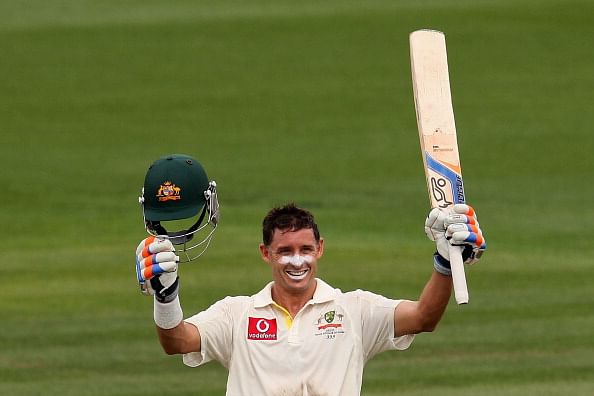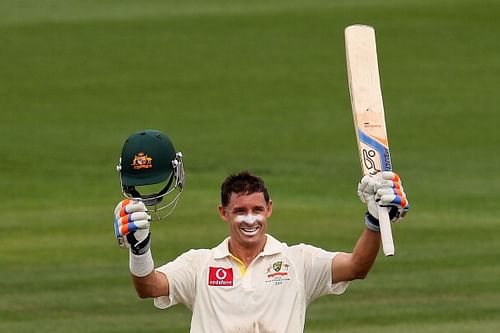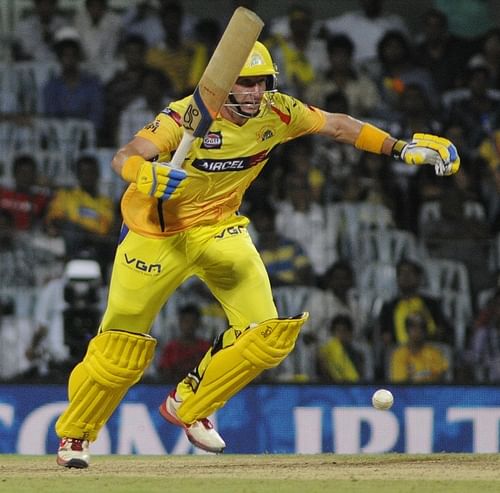
Michael Hussey: the fantastic Mr. Cricket

Mr. Cricket: Michael Hussey of Australia pictured here in 2012, celebrates after scoring a century against Sri Lanka in Hobart, Australia. (Getty Images)
Most men would be flattered, but he absolutely hates it – the moniker that’s become his identity. Andrew Flintoff thought it’d be a good idea to call him that at a post-match presentation in 2006. Flintoff was floored by his fanatic love for cricket back then, and said how he’d be the “first to practice and the last to leave, hitting balls in every spare minute.” It stuck, and how.
When Michael Edward Killeen Hussey landed himself the coveted baggy green, he was already 30. He was the father of three, had a bit of a reputation as a player of football and squash, and even had a teaching degree. In another universe, he’d have been a science teacher living in the suburbs of Perth who’d play ball with his kids on weekends. In another universe, he’d have had quit playing cricket when he was continually ignored by national selectors for ten long years.
Hussey knew he was born to play the game. Cricket had been his heartbeat since he was 12. That was when he discovered he was more comfortable batting left-handed than otherwise. Soon enough, he was playing club cricket at Perth, just one of a thousand blokes trying to make it big on the Australian domestic circuit. The biggest obstacle he faced at that point was size, or the lack of it. He was small, reedy and extremely shy, and his mentor Ian Kevan realized this apparent lack of toughness could cost the talented teen the spotlight he deserved. The one other individual who saw Hussey’s potential was his team-mate who was light years ahead of him on the road to international cricket – Damien Martyn.
Hussey was far from discouraged. He made it to the Australia A squad after three years of relentless net sessions, protein diets and pumping iron. One fine day, his new coach Allan Border suggested that he have a six-hour training session in the nets. Border had meant it as a joke, but Hussey went ahead and did it all the same, and absorbed it into his daily routine.
The sheer determination that illuminated his path was channelled from his parents, particularly his father, who was a former sprinter and athletics coach. He once said in an interview: “Our parents impressed on us that you don’t get anywhere without hard work. Dad didn’t know about cricket, but he knew what it took to be successful, that single-mindedness. A lot of it, though, we were born with – the desire to be the best.”
The teenage years were at an end, and Hussey had to choose between the sports he loved. He realised he was still not the right size for football, and squash began to bore him because it was an individual game. Cricket was the automatic choice.
It wasn’t the easiest one, however, as he soon found out. Western Australia and County cricket hailed his many talents, but the national selectors remained resolutely oblivious. It took three triple hundreds in the County Championships and a record 15,313 first-class runs before the calls for his inclusion in the international side became too loud to turn a deaf ear to. Mike Hussey had taught his generation of cricketers an important lesson in patience and steadfastness even before he stepped on to play his first international match.
And when he finally did, he was a revelation. It took him a little over 150 days to reach 1000 Test runs; a year later his batting average hovered around 90.
Among other things, it was the finesse with which he batted that caught the attention of cricket lovers worldwide. Here was a man who wouldn’t use a bat like an ice-cream scoop or a shovel even if you paid him to do it. He’d bat the way one is supposed to bat, like a conductor leading an orchestra, with the delicacy of a Sous-Chef de Cuisine and the sophistication of a ballet. Here was a man who displayed his love and adoration of the game with every ball he caressed to the boundary with fluid, crisp movements.
The inevitable comparisons to the Don himself began, but Hussey didn’t seem to pay attention. He soon cemented his place in the side, and racked up one batting exploit after another. Captaincy didn’t come naturally to him, as is the case for many a great player. That didn’t lessen the fact that he was a natural leader; the sight of Hussey shouting words of encouragement from gully or walking up to an assaulted bowler to pat him on the back was not uncommon.

Mr. Reliable: Hussey has been in fine form for CSK in this year’s IPL. (IANS Photos)
Though Test cricket is admittedly his favourite brand of the game, Hussey quickly adapted to the other two formats. T20 brought out the flashier end of his blade, and his 24-ball 60 led Australia to what is regarded as one of the most thrilling run chases in T20I cricket in the semi-finals of the ICC World Cup in May 2010.
Hussey is one of those rare cricketers who didn’t overstay their welcome; if anything he seems to have bowed out way sooner than he should have. The romance is far from over; he continues to play for Chennai Super Kings and this tenure has earned him another set of fan legions. This is the first edition of the Indian Premier League since his farewell Test at the SCG last year, and he’s been breathing fire all over the subcontinent. He has already amassed 445 runs in 8 matches at an astounding average of 74, with four half-centuries. He had never once opened for his national side but he opens for CSK. Excellent at gauging the nature of a match and adapting to the situation, he has been labelled by CSK coach Stephen Fleming as a “pillar of strength” and a “role model for the entire team.”
And so the saga continues. Mike Hussey has left quite the void in Australian cricket, and in the sport itself as a whole. He left so quietly and subtly that we find ourselves cherishing and celebrating his international career rather than ruing that it’s over.
Thank you, Mr. Hussey. Apologies, though, for the moniker stays.